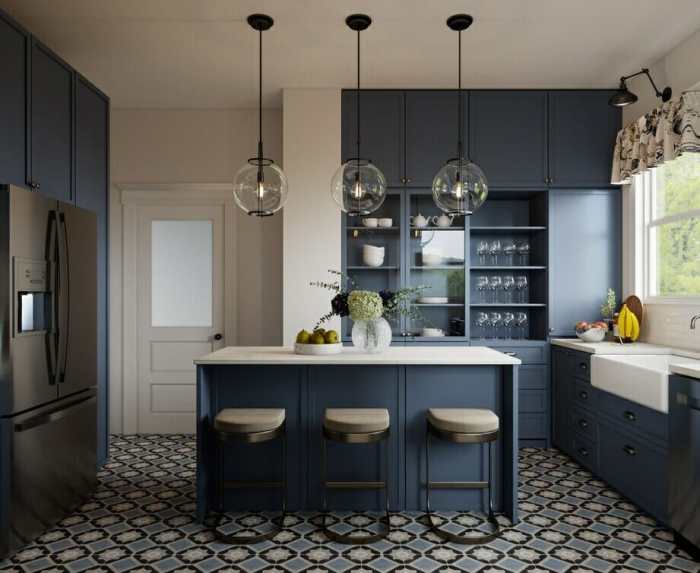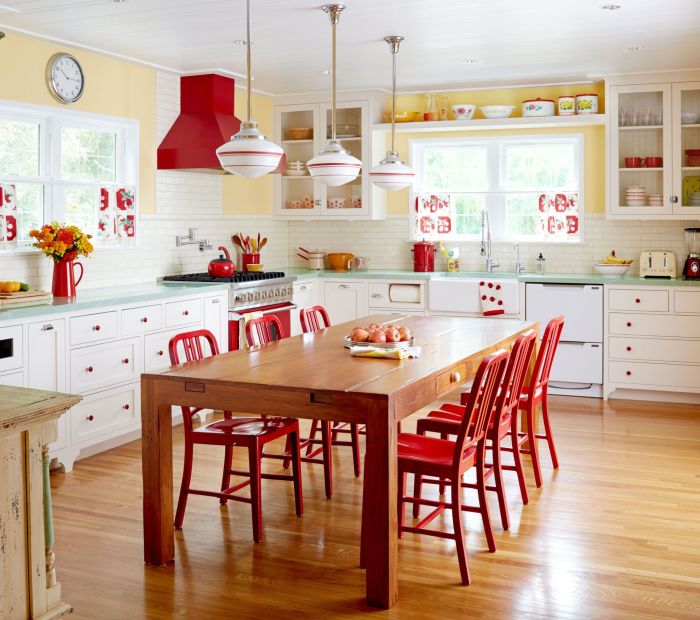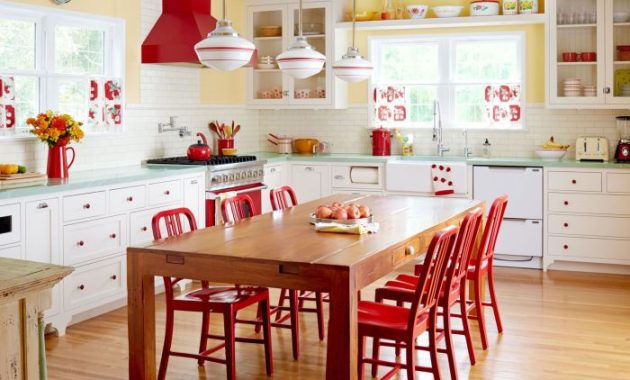Defining “Vintage” Kitchen Decor
Vintage decor for kitchen – Vintage kitchen decor evokes a sense of nostalgia, drawing inspiration from past eras and incorporating their distinct styles and aesthetics. It’s more than just “old”; it’s a curated selection of elements that create a cohesive and charming atmosphere, reflecting a specific period or a blend of several. The key is to achieve a balanced look that feels intentional and stylish, not simply cluttered with random antiques.
Different vintage styles offer unique visual characteristics, creating vastly different moods and feels. The choice depends largely on personal preference and the overall aesthetic of the home.
Mid-Century Modern Kitchen Characteristics
Mid-century modern kitchens, typically dating from the 1950s and 1960s, are defined by their clean lines, functionality, and a focus on natural materials. Imagine sleek cabinetry in warm walnut or teak, paired with chrome hardware that gleams under the light. The color palette often features muted earth tones – think avocado green, burnt orange, mustard yellow – balanced with crisp whites and blacks.
Materials commonly used include wood, chrome, and laminate, reflecting the era’s embrace of new technologies and manufacturing processes. A vintage clock with bold geometric numbers and a retro pendant light fixture would perfectly complement this style.
Choosing vintage decor for your kitchen brings a unique charm, a nostalgic touch to your cooking space. If you’re aiming for a rustic feel, consider incorporating elements of vintage farm kitchen decor , which often includes repurposed wooden furniture and enamelware. This style blends seamlessly with the overall appeal of vintage kitchen aesthetics, adding warmth and character to your home.
Farmhouse Kitchen Characteristics
Farmhouse kitchens offer a rustic charm, often incorporating repurposed and antique elements. Think distressed wooden cabinets, open shelving displaying vintage enamelware, and a large, farmhouse-style sink. The color palette is typically warmer and more muted, using creamy whites, soft blues, and natural wood tones. Materials like reclaimed wood, cast iron, and ceramic are prevalent, contributing to the feeling of warmth and history.
Imagine a vintage wooden rolling pin hanging near a window, letting in natural light that accentuates the patina of the wood.
Victorian Kitchen Characteristics
Victorian kitchens (late 19th century) exude elegance and ornate detail. Think dark, rich wood cabinetry, perhaps with intricate carvings, paired with brass or porcelain hardware. The color palette is typically deeper and more dramatic, incorporating jewel tones like emerald green, ruby red, and sapphire blue. Materials like dark wood, marble, and ornate metalwork are characteristic, creating a sense of grandeur and sophistication.
A vintage copper pot hanging above the stove and decorative ceramic tiles add to the richness of the overall design.
Vintage Kitchen Color Palettes
The color palettes used in vintage kitchen decor are as diverse as the styles themselves. Mid-century modern leans towards muted earth tones and pastels, while farmhouse kitchens favor warmer, more natural shades. Victorian kitchens, on the other hand, often employ rich, deep colors. The consistent thread is the use of colors that are not harsh or overly bright; they are generally softer and more inviting, reflecting the time periods they emulate.
The careful selection of color is key to creating an authentic and cohesive vintage look.
Materials Used in Vintage Kitchen Decor
The materials used in vintage kitchen decor are integral to achieving the desired aesthetic. Wood, in various finishes and styles, is a staple across all vintage styles. Metal, whether chrome, brass, or cast iron, adds both functionality and visual interest. Ceramic is another key material, seen in everything from tiles to cookware. These materials, often chosen for their durability and timeless appeal, contribute significantly to the character and longevity of a vintage kitchen design.
The tactile quality of these materials adds another layer to the overall experience.
Key Design Elements of Vintage Kitchens: Vintage Decor For Kitchen

Vintage kitchen design evokes a sense of nostalgia, transporting us to bygone eras of charming functionality and timeless aesthetics. These kitchens, while often smaller than their modern counterparts, are characterized by thoughtful layouts and a focus on craftsmanship that prioritizes both beauty and practicality. Understanding these key elements allows for a successful recreation of this beloved style.
The typical layout and functionality of vintage kitchens often involved a compact, efficient design. Think galley kitchens with linear workspaces maximizing every inch, or L-shaped layouts that cleverly incorporated storage and appliances within a limited footprint. Functionality was paramount; built-in cabinetry, often featuring detailed woodwork and charming hardware, provided ample storage. A large, often farmhouse-style, sink served as the central hub, flanked by countertops crafted from materials like butcher block or enamel.
Appliances, while perhaps less technologically advanced than modern equivalents, were integrated seamlessly into the overall design, showcasing a commitment to both form and function.
Vintage Lighting Fixtures Create Ambiance
Strategic lighting is crucial in establishing the vintage aesthetic. Picture a kitchen illuminated by a stunning pendant light fixture, perhaps a milk-glass shade hanging over the kitchen island, casting a soft, warm glow. Alternatively, a series of vintage-style sconces mounted on the walls could provide task lighting while adding to the overall charm. Consider using Edison-style bulbs for a truly authentic touch, their warm, amber light perfectly complementing the rustic or antique elements of the space.
The careful selection and placement of lighting fixtures is paramount in creating the right atmosphere, transforming the kitchen into a warm and inviting space that exudes a sense of history and character.
Incorporating Vintage Textiles
Vintage textiles add texture and personality to a vintage-style kitchen. Imagine cheerful, floral-printed curtains framing a window, filtering sunlight and adding a touch of delicate color. A well-worn, patterned rug placed beneath a kitchen table or in front of the sink adds warmth and visual interest to the floor, potentially echoing the colors or patterns found in the cabinetry or other decorative elements.
Don’t forget the smaller details – charming dish towels in vintage-inspired prints or a crocheted tea cozy perched on a teapot add the finishing touches to this carefully curated aesthetic. These seemingly small elements work together to create a cohesive and inviting atmosphere that evokes the feeling of a cherished family heirloom.
Creating a Vintage Kitchen Mood Board

A mood board is a crucial first step in designing any room, especially one as character-driven as a vintage kitchen. It allows you to visualize the overall aesthetic, ensuring cohesion and preventing design clashes. By compiling images, textures, and color swatches, you create a tangible representation of your dream vintage kitchen, guiding your choices throughout the renovation or decorating process.
This visual roadmap helps maintain a consistent style and prevents impulsive decisions that might detract from the desired atmosphere.
Vintage Kitchen Mood Board: A Sample Design, Vintage decor for kitchen
Creating a mood board involves selecting elements that resonate with your chosen vintage style. The table below provides a sample, illustrating how diverse elements contribute to the overall design. Remember, your board should reflect your personal taste and chosen vintage era.
| Item | Description | Style | Source |
|---|---|---|---|
| Cabinetry | Cream-colored shaker-style cabinets with aged brass hardware. Slightly distressed finish to emphasize age. | 1930s Farmhouse | Antique store/Custom made with distressed finish |
| Backsplash | Subway tiles in a soft white, offset with a dark grout for visual interest. | Classic Americana | Home improvement store |
| Countertops | Butcher block countertop, showing natural wood grain and patina. | Rustic Farmhouse | Custom fabrication/Salvaged |
| Lighting | Pendant lights with seeded glass shades, providing a warm, ambient glow. | 1940s Industrial | Antique shop/Lighting store |
| Appliances | Vintage-inspired range with a classic design and cream enamel finish. | 1950s Retro | Restoration Hardware/Secondhand Market |
| Flooring | Wide-plank wood flooring, slightly worn for character. | 1920s Craftsman | Reclaimed wood supplier/Home improvement store |
| Accessories | Open shelving with vintage enamelware, cast iron cookware, and vintage canisters. | Eclectic Vintage | Flea markets/Antique shops |
Illustrative Vintage Kitchen Scene
Imagine a sun-drenched kitchen, bathed in the warm glow of pendant lights with seeded glass shades. These lights cast a soft, diffused illumination across cream-colored shaker cabinets, their slightly distressed finish whispering tales of years gone by. The butcher block countertop, rich with the patina of age and use, provides a tactile counterpoint to the smooth, cool subway tile backsplash.
The overall color scheme is a gentle blend of creamy whites, warm wood tones, and touches of aged brass. Textures are layered – the smooth coolness of the tiles against the rough warmth of the wood, the subtle gleam of the brass hardware. The air is filled with the comforting scent of freshly baked bread, a tangible element adding to the cozy, inviting atmosphere.
Vintage Styles and Evoked Moods
Different vintage styles evoke distinct moods. A 1950s retro kitchen, with its bold colors and streamlined design, exudes a playful, optimistic energy. Conversely, a 1920s Arts & Crafts kitchen, with its handcrafted details and natural materials, fosters a sense of calm and handcrafted quality. A rustic farmhouse kitchen, characterized by its worn wood and vintage textiles, cultivates a feeling of warmth and homely comfort.
The choice of vintage style directly influences the emotional atmosphere of the space, reflecting the homeowner’s personality and desired ambiance.
Query Resolution
How do I clean vintage ceramic cookware without damaging it?
Use mild dish soap and warm water, avoiding harsh abrasives. Hand-washing is generally preferred. For stubborn stains, soak in a solution of baking soda and water.
Where can I find affordable vintage kitchen textiles?
Thrift stores, online marketplaces like eBay and Etsy, and even antique shops often have surprisingly affordable vintage textiles. Look for sales and discounts.
How can I prevent my vintage wooden cutting board from warping?
Oil your wooden cutting board regularly with mineral oil to prevent dryness and warping. Avoid prolonged exposure to water.
What are some signs of a genuine vintage item?
Look for signs of age like patina, wear, and minor imperfections. Check for maker’s marks and construction techniques consistent with the era. Research the style and manufacturer for authenticity.

